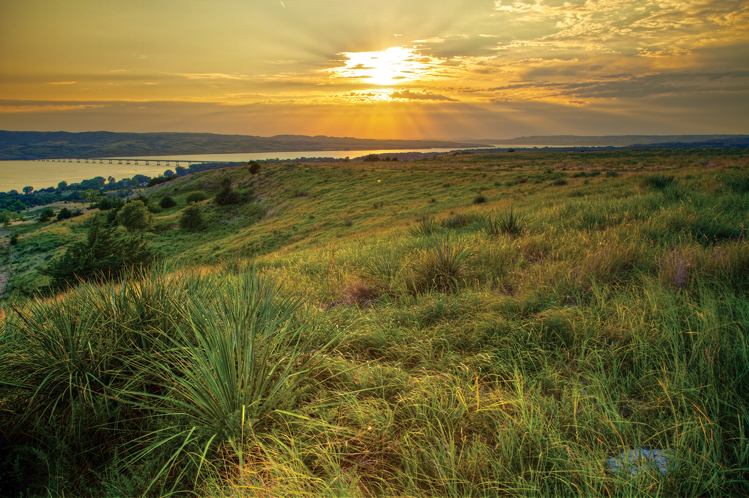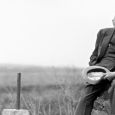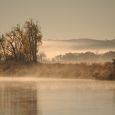The Gift of South Dakota
Subscriptions to South Dakota Magazine make great gifts!
Subscribe today — 1 year (6 issues) is just $29!
Why South Dakota?
 |
| The rolling hills along the Missouri River near Platte are an attribute that draws Fraser Harrison to South Dakota. Photo by Christian Begeman. |
I was lost. Somewhere west of Springfield in Bon Homme County I had missed a vital turn that would have taken me to Marty and the Yankton Indian Reservation by way of the Scenic Byway that runs parallel with the Missouri River. Surrounded by fields of green corn, I was now adrift in a network of straight and seemingly endless dirt roads, none of them on the map, all terminating in junctions without signs. Mine appeared to be the only vehicle trapped in this labyrinth, and while I passed several fields occupied by contented cattle, I drove for many miles before seeing a farmhouse close to the road. I drew into the yard to ask for directions.
As a rule the traveler is well advised to be wary of farm dogs. But on this occasion the creature in question was a grizzled, moth-eaten Corgi that was wagging its stump of a tail and appeared to be friendly enough. I got out of my car and walked into the farmyard. Using what I hoped was a reassuring tone, I asked the mutt where his owner was. Giving the equivalent of a canine shrug, he looked around the yard, which was deserted, though signs of life could be seen everywhere. A barn stood open with a tractor at the ready in its doorway. I walked over and called out. The dog followed me, apparently as interested in the outcome as I was. We looked into buildings and workshops, but got no response. Finally, we climbed the stoop and knocked at the door of the farmhouse. I could see lights burning inside. I shouted, the dog looked expectantly, but still no answer came. I was forced to say farewell to the amiable janitor of this forsaken property and drive away.
Guided by my compass, I reckoned that if I kept going west or south whenever I was offered the choice I was bound to hit the river eventually. And, sure enough, after another 20 minutes the land began to undulate and lines of cottonwoods appeared, telling me that the riverbed was close. When at last I saw the Missouri River, it was a mere trickle wandering aimlessly among yellow sandbanks that had invaded its ample course. A little further upstream, where the channel was narrower, the water was flowing vigorously, but its surface was bristling with scores of snags. Blackened branches and trunks of trees were rooted in the mud and angled like spears placed to repel a raid.
I had found my way. Furthermore, I had reconnected with the river that is South Dakota’s great artery, the river that has determined much of its history, the river that splits both the state and the continent. I can never contemplate the Missouri without a pang of respect for this leviathan, which like the plains that form its basin belongs to a mammoth category of nature not found in our islands.
Why return so repeatedly to a state not famous for its beauty? Even at its dullest, South Dakota possesses a quality that is both charismatic and hard to define.
No one likes to be lost, but it is a condition I am used to. Thanks to having no sense of direction, I suffer from a virtual disability when making journeys — hence the compass in my car that is as valuable to me as my passport. But if I had to be lost, this was the landscape in which I preferred to have it happen.
I have been coming to South Dakota for more than 20 years, and its topography still has not lost the power to excite me. Why return so repeatedly to a state not famous for its beauty (excepting the Black Hills)? It is a question that always smacks of condescension when it comes from someone, American or otherwise, who lives outside the state. And it is a question that I always feel I answer inadequately when it comes from a resident. True, parts of East River may sometimes appear featureless, and its roads may sometimes dismay the most optimistic driver as they relentlessly unwind across the prairie, turning a slight rise into a positive adventure. But even at its dullest, South Dakota possesses a quality that, for me, is both charismatic and very hard to define.
I live in the eastern part of England, not far from Cambridge, which is an area that is largely flat and fertile, a kind of miniature equivalent to the American Midwest and known as the “breadbasket of England.” By upbringing and inclination I am an urbanite (Liverpool), but I have come to value my adopted region for its spacious, uninterrupted skies. These are the skies that John Constable, the English artist, painted so movingly in the 19th century, capturing their luminous airiness and moist, cloudy hurly-burly. He believed that the sky in a picture was “the chief organ of sentiment,” and over the years I have been lucky enough to live in houses that have had views encompassing the open sky and distant horizons, views that seemed charged with the emotional dimension that obsessed the painter. That emotion has primarily been the very English one of submitting philosophically to the weather, as we must submit to time and our biological fate, by rejoicing in sunshine and blue skies when they come, while always knowing that cloud and rain may soon replace them. To that degree, we are Stoics.
But our East Anglian skies are miniatures by comparison with the immensities of deep blue that open above the South Dakota grasslands, and it is this vastness of scale that calls me back year after year. (I know that skies of similar immensity are to be found in other states, most famously Montana and its self-styled “big sky country.” However, Montana is also a mountainous state, and it is the particular quality, exemplified by South Dakota, created by the horizontal profile of the prairies and grassland and their infinitely extensible horizons, to which I have become addicted.) The English countryside is full of variety, and every turn in the road can bring fresh and surprising beauty, but the fact is the road is often narrow and enclosed by hedges. Our geography is small-scale, which is the secret of its picturesque changeability, but that does not protect some of us from occasional twinges of claustrophobia. As a result, the sensation of exchanging the confines of my local countryside for the limitless spaces of South Dakota is always prodigious. It is like opening a little gate in a wall and stepping out of a pretty English garden (there are none prettier) only to discover that I have joined the Lewis and Clark expedition and now face an unmapped wilderness.
I am talking about the sensation that overwhelms me whenever I leave the airport in Sioux Falls and begin a new journey into the state, especially on a fine summer’s day when the sky has acquired that piercing azure color we never see in England, and the white clouds (cumulus mediocris) are strung out like prairie schooners and can almost be heard to creak as they lumber across the horizon, and — to complete the picture — a turkey buzzard is already lolling on a thermal, methodically spiraling as if it hopes to sniff out carrion in the panorama below. I feel as if my soul is expanding within me while the landscape unrolls beyond my car windows. The eye is suddenly let loose to run as far as it can in all directions, to the very frontier of visibility. As with the eye, so with the mind; the sensation is at once external and internal. Though I am surrounded by what has become a domesticated terrain earning its keep as farmland, its sheer scale makes me feel as if my own capacities — for thinking, for feeling, for loving — have been enlarged in proportion with the topography. I feel intoxicated, capable of anything; I feel liberated; I feel taller, fitter, younger; I feel invested with infinite possibility.
I do not feel diminished when I return home to the cozier dimensions of my Suffolk scenery; nor do I feel that I have left behind the qualities, however illusory, with which I felt the prairie had empowered me. Adjustments have to be made; jet lag and post-travel blues demand their malicious fee; but in the end I know that my mind and soul have been amplified. With each visit some mysterious process of spiritual transportation ensures that what could be called my mindscape has been enriched by the South Dakotan factor.
Editor’s Note: This story is revised from the September/October 2014 issue of South Dakota Magazine. To order a copy or to subscribe, call (800) 456-5117.










Comments